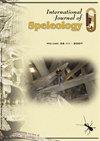洞穴内的蓝藻及其处理:一个新出现的生态问题
IF 1.3
4区 地球科学
Q3 GEOSCIENCES, MULTIDISCIPLINARY
引用次数: 30
摘要
:洞穴的人工照明适合旅游,导致了一个复杂的光营养生物群落的出现和繁殖,该群落被称为“lampenflora”。它们主要由藻类和蓝藻形成,对定植基质产生降解作用,降低了洞穴的显示价值。这一现象在20世纪60年代因拉斯科洞穴(法国)的画作受损而闻名于世。从那时起,这已经成为展览洞穴管理者和国际科学界严重关注的问题。随着时间的推移,人们采取了两种互补的策略来解决这个问题:防止入侵生物的定植,或者在它们通过使用化学产品(主要是杀生物剂和强氧化剂)建立后将其消灭。这种处理产生的污染物可以将问题从洞穴的墙壁转移到地下水中。本文对该问题和提出的解决方案进行了批判性的文献综述,并强调需要进一步研究处理化学品的最佳剂量,并开发定量方法来确定其有效性。本文章由计算机程序翻译,如有差异,请以英文原文为准。
The lampenflora in show caves and its treatment: an emerging ecological problem
: The artificial lighting of caves adapted for touristic visits, leads to the appearance and propagation of a complex community of phototrophic organisms known as “lampenflora”. Formed mainly by algae and cyanobacteria, they produce the degradation of the colonized substrates and decrease the show value of the caves. This phenomenon became famous worldwide in the 1960s due to the damage caused to the paintings in the Lascaux Cave (France). Since then it has become an issue of serious concern to both managers of show caves and to the international scientific community. Over time, the problem has been approached following two complementary strategies: preventing colonization by the invading organisms or eliminating them once they have become established through the use of chemical products, mainly biocides and strong oxidants. This kind of treatment generates pollutant effluents that can move the problem from the walls of the caves to the groundwater. This paper presents a critical literature review of the problem and the proposed solutions, and emphasizes the need for further study of the optimal doses of treatment chemicals and to develop quantitative methods to determine their effectiveness.
求助全文
通过发布文献求助,成功后即可免费获取论文全文。
去求助
来源期刊

International Journal of Speleology
地学-地球科学综合
CiteScore
3.10
自引率
23.10%
发文量
12
审稿时长
>12 weeks
期刊介绍:
The International Journal of Speleology has the aim to get cave and karst science known to an increasing number of scientists and scholars. The journal therefore offers the opportunity to all scientists working in and on karst to publish their original research articles or their review papers in an open access, high quality peer reviewed scientific journal at no cost. The journal offers the authors online first, open access, a free PDF of their article, and a wide range of abstracting and indexing services.
 求助内容:
求助内容: 应助结果提醒方式:
应助结果提醒方式:


